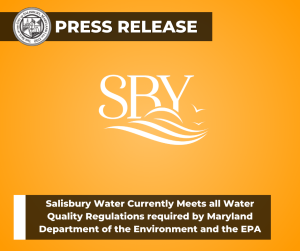
Salisbury, MD – The City of Salisbury’s water currently meets all water quality regulations required by the Maryland Department of the Environment and the U.S. Environmental Protection Agency.
While newly released EPA regulations brought increased attention to the existence of PFAS (Per and Polyfluoroalkyl Substances) in drinking water nationwide, the City has been planning for the eventuality for years and researching solutions for our water system to meet the new standards, which do not go into effect until 2029.
“These regulations did not come as a surprise,” said Director of Water Works Cori Cameron. “We understand that residents are concerned about the water they use every day. The City of Salisbury did not create this problem, but we have been and are currently working to correct it. The new rules allow water systems five years to plan, design and find the best solutions for their community.”
In January of 2024, the City applied to the Maryland Department of the Environment for the Drinking Water Quality State Revolving Loan Fund Bipartisan Infrastructure Law Funding for PFAS/Emerging Contaminants (100% loan principal forgiveness for projects that address PFAS and emerging contaminants in drinking water), to complete a study at the Park and Paleo Water Treatment Plants to find the best treatment technique to remove the PFAS from our water.
The EPA is setting enforceable Maximum Contaminant Levels (MCLs) at 4.0 parts per trillion for PFOA (Perfluorooctanoic acid) and PFOS (Perfluorooctane sulfonic acid) individually. Those are two of the most pervasive PFAS and their production was phased out in the early 2000s due to public outcry, but companies simply turned to other formulations that present similar if not the same dangers.
“The City of Salisbury has sampled totals (for PFOA and PFOS) as high as 7.53 parts per trillion and a low of 3.2 ppt with a combined well field total of 14 parts per trillion,” Cameron said. “For Perspective: One part per trillion is equivalent to one drop of impurity in 500,000 barrels of water, or traveling 6 inches out of a 93 million mile journey toward the sun.”
The Paleo Water Treatment Plant will embark on bench-scale testing to determine the level of treatment needed. We are in the process of pricing out a change order to add the design of a Granular Activated Carbon filter system to our new filter treatment building at the Paleo Water Treatment Plant. The preliminary construction cost estimate for the GAC filters will be $14 million.
The Park Water Treatment Plant Study will be used to find the best resource for treatment. The study will include bore tests for deeper wells to see if that eliminates the PFAS and a bench test study to find the best treatment system for the plant and design of new wells or a new treatment system.
Salisbury will apply for federal grant money in January of 2025, for both plants for the construction of the treatment system to remove PFAS.
The City has also entered into a nationwide lawsuit against the producers of these chemicals.
PFAS is a large group of complex synthetic chemicals that have been used in consumer products around the world since 1950. They are used to keep food from sticking to packaging or cookware, make clothes and carpets resistant to stains, and create more effective firefighting foam.
PFAS molecules have a chain of linked carbon and fluorine atoms. Because the carbon-fluorine bond is one of the strongest, these chemicals do not degrade easily in the environment and are known as “forever chemicals” for that reason.
While PFOA and PFOS are no longer utilized in current manufacturing, the ones that were created for years are still in our environment. In addition, a newer class of PFAS sometimes termed GenX Chemicals are now proliferating.
The EPA is setting maximum contaminant levels of these chemicals like PFNA, PFHxS, and HFPO-DA at 10 ppt.
Common items in your household that can include the newer PFAS are: Microwave popcorn bags, clothing, footwear, non-stick cookware, pizza boxes, candy wrappers, floss, toilet paper, cleaning products, nail polish, shampoo, plumbers tape, carpets, carpet padding, cell phones, furniture, mattresses, varnish, guitar strings, contact lenses, umbrellas, cosmetics and many others.
These chemicals are also used in the aerospace, automotive, construction, and electronics industries. Over time, PFAS may leak into the soil, water, and air. This can happen through manufacturing processes, from burning waste that includes PFAS and leaching from landfills. PFAS is even found in your household dust.
New regulations require that public water systems must monitor for these PFAS — which the City is already doing — and have three years to complete initial monitoring (by 2027), followed by ongoing compliance monitoring.
However, manufacturers don’t have to disclose to consumers that they’re using them and the EPA doesn’t regulate or test for most PFAS chemicals.
“While the EPA is currently focused on water quality and removing these contaminants to the extent that current science allows, some of these chemicals are still being manufactured and used in common household products that people use every day,” Cameron said. “As long as they are manufactured and used they will continue to be in our environment and consumers will continue to pay to remove it from our water systems.”
For more information on PFAS please go to the Department of Water Works website Salisbury.md/departments/
New EPA Regulations at a glance
On April 10, 2024, the Environmental Protection Agency issued the final National Primary Drinking Water Regulations for six Per- and Polyfluoroalkyl Substance (PFAS) establishing legally enforceable levels, called Maximum Contaminant Levels (MCLs), for six PFAS in drinking water. PFOA, PFOS, PFHxS, PFNA, and HFPO-DA as contaminants with individual MCLs, and PFAS mixtures containing at least two or more of PFHxS, PFNA, HFPO-DA, and PFBS using a Hazard Index MCL to account for the combined and co-occurring levels of these PFAS in drinking water. EPA also finalized health-based, non-enforceable Maximum Contaminant Level Goals (MCLGs) for these PFAS.
The final rule requires:
- Public water systems must monitor for these PFAS and have three years to complete initial monitoring (by 2027), followed by ongoing compliance monitoring. Water systems must also provide the public with information on the levels of these PFAS in their drinking water beginning in 2027.
- Public water systems have five years (by 2029) to implement solutions that reduce these PFAS if monitoring shows that drinking water levels exceed these MCLs.
- Beginning in five years (2029), public water systems that have PFAS in drinking water which violates one or more of these MCLs must take action to reduce levels of these PFAS in their drinking water and must provide notification to the public of the violation.
- EPA is setting enforceable Maximum Contaminant Levels (MCLs) at 4.0 parts per trillion for PFOA and PFOS individually.
- This standard will reduce exposure from these PFAS in drinking water to the lowest levels that are feasible for effective implementation.
- For PFNA, PFHxS, and HFPO-DA (GenX Chemicals) setting MCLS of 10 Parts per trillion.





